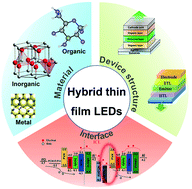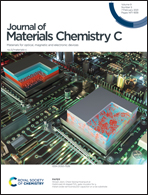Organic–inorganic hybrid thin film light-emitting devices: interfacial engineering and device physics
Abstract
Thin film light-emitting devices (LEDs) with sandwich structures, such as organic light emitting devices (OLEDs), quantum dots LEDs (QLEDs) and perovskite LEDs (PeLEDs), have attracted wide attention because of their huge potential in display and lighting applications. It's generally known that semiconductors are the material basis of these thin film LEDs. Until now, both organic and inorganic semiconductors have been developed and used to achieve efficient carrier injection, carrier transport and exciton recombination radiation. Thus, almost all recent thin film LEDs belong to the class of organic–inorganic hybrid devices. Organic–inorganic hybrid films play key roles in achieving high device performances. In this review, we will highlight the development of thin film LEDs from the perspective of organic–inorganic hybrids. Organic and inorganic functional layers, organic–inorganic heterojunctions and hybrid thin-film LEDs will be introduced. The requirements of efficient organic–inorganic hybrid LEDs in respect of interfacial engineering and device physics are discussed as well.



 Please wait while we load your content...
Please wait while we load your content...